


xxxxxAs we have
seen, the American inventor Thomas Alva Edison was the first to
produce motion pictures via his Kinetoscope, first shown in 1891. However, he then
attempted to add sound to his peep-show machine, leaving
others to take the next related step, the projection of these
moving images onto a large screen for general viewing. The French
brothers, Auguste and Louis Lumière achieved this in December 1895. With their combined
camera and projector, the Cinématograph, they put on a film show
in Paris attended by a paying audience. Because of the quality of
their production - ten short films - the Lumière
brothers are generally credited with opening the world’s first
cinema, but others have claimed this distinction. Seven months
earlier, for example, an American named Woodville Latham, assisted
by his two sons, filmed a boxing match and, using a screen, showed
it to a paying audience in New York, and the German brothers Max
and Emil Skladanowsky showed
a number of short films, just a few seconds long, at the Winter
Garden in Berlin in November 1895. However, unlike the Cinématograph
Lumière, neither of these inventions stood the test of
time. The Skladanowsky Brothers went out of business in 1897 and
Latham a year later.
THE LUMIÈRE BROTHERS 1895 (Vc)
AUGUSTE 1862 -
1954 (Vb, Vc,
E7, G5, G6, L2)
LOUIS 1864 - 1948
(Vb, Vc, E7, G5, G6)
Acknowledgements
Brothers: date
and photographer unknown. Poster: by the
French artist Marcellin Auzolle (1862-1942), 1895. Projector: 1895, photographer unknown. Derby:
1895, Ray Henville Collection, National Film and Television
Archive, London. Moon: sketch by the
filmaker Georges Méliès (1861-1938), for his A
Trip to the Moon, published 1902.
xxxxxAs we have
seen, the American inventor Thomas Alva Edison was the first -
or certainly one of the first - to produce motion pictures.
His Kinetoscope, a peep show which enabled one person at a time to
view a rapid succession of individual images, was given its first
public showing in 1891,
and was in commercial use by 1894. But having achieved enormous
success with this machine on both sides of the Atlantic, he then
chose to turn his attention to the possibility of adding sound to
sight. His Kinetoscope was extremely popular and selling well, and
he therefore saw no reason to put his research into finding a
means of projecting these moving images onto a screen. In his
opinion this had little commercial value, and would only serve to
“kill the goose that lays the golden egg”.
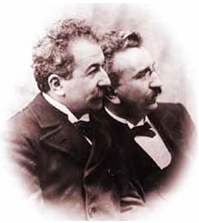
xxxxxBy the time
Edison came to realise the potential of the movie screen, the
sales of the Kinetoscope had plummeted, and other inventors had
given birth to the age of the cinema. One of the first - if
not the first - to produce a movie
show for a paying audience were the Lumière Brothers, Auguste and
Louis (illustrated).
Having produced their own projector, their cinématographe, they
projected moving pictures onto a screen in Paris in December 1895.
xxxxxThe Lumière
Brothers were born in Besançon and, as young men, worked in their
father’s photographic firm in Lyons. There they gained a great
deal of hands-on experience about the photographic industry,
and came up with a number of improvements to the developing
process. It was in 1894, after seeing Edison’s Kinetoscope at work
in Paris, that they decided to design a camera of their own which
would be able to project motion pictures onto a screen for general
viewing. By February 1895 they had
produced a working model of their cinématograph, a combined camera
and projector, and by the end of December they were ready to give
their first public movie-screening. (Poster illustrated
below). This was held in the Salon Indien of the Grand Café
in the Place de l’Opéra, Paris, where
some 35 people paid to see ten short clips, including a 50-second
sequence showing workers leaving their father’s factory at Lyon,
and The Sprinkler Sprinkled, depicting
the amusing capers of a gardener using a watering hose.
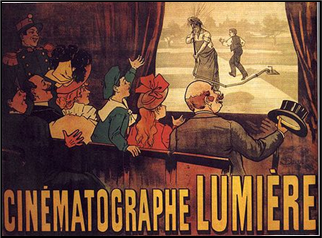 xxxxxThis public screening - the showing of a
sequence of moving pictures which was no longer restricted to a
peepshow for one - gave birth to a film industry overnight.
The brothers began commercial production of their camera-cum-projector,
and a host of other inventors and entrepreneurs got in on the act
in order to meet the needs of the “big screen”. The age of the
cinema had begun. It is generally accepted that the 28th December
1895 - the date of the Lumières’ commercial exhibition -
marks the opening of the world’s first cinema. Their camera/projector
proved up to its task and the 16 frames per second became the
standard speed. Furthermore, the showing was certainly held in a
“cinema” setting; and those attending were charged an entrance
fee.
xxxxxThis public screening - the showing of a
sequence of moving pictures which was no longer restricted to a
peepshow for one - gave birth to a film industry overnight.
The brothers began commercial production of their camera-cum-projector,
and a host of other inventors and entrepreneurs got in on the act
in order to meet the needs of the “big screen”. The age of the
cinema had begun. It is generally accepted that the 28th December
1895 - the date of the Lumières’ commercial exhibition -
marks the opening of the world’s first cinema. Their camera/projector
proved up to its task and the 16 frames per second became the
standard speed. Furthermore, the showing was certainly held in a
“cinema” setting; and those attending were charged an entrance
fee.
xxxxxHowever,xas was to be expected, claims were made of earlier
showings. Prime among these was a four minute film of a staged
boxing match, filmed on the roof of Madison Square Garden in May
1895, by Woodville Latham
(1837-1911), a one-time professor of chemistry at West
Virginia University, and his two sons Otway and Gray. The previous
year they had produced a movie camera and projector with the
assistance of Eugène Lauste (1857-1935), a former employee of Edison’s
company, and William Dickson, then Edison’s chief engineer, who
was working for them unofficially. At the end of May 1895 this
four-minute motion picture was shown to a paying audience at
a small store in Broadway, New York, more than seven months before
the Cinématographe Lumière. However,
the method of projection - simply a modified Kinetoscope -
proved inadequate, and one magazine in particular, the Photographic
Times, saw “considerable room for improvement”. Plagued
with legal and technical problems their enterprise, the Lambda
Company, went out of business in 1898.
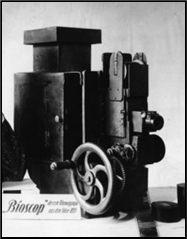 xxxxxAxmore valid challenge was
that made by the German inventor Max
Skladanowsky (1863-1939) and his
brother Emil.
In 1895 they invented the Bioskop, a projector based on the
workings of a magic lantern, which used two loops of 54mm film -
projected alternatively - and attained a speed of 16 frames
per second (illustrated). They gave a demonstration in Pankow, Berlin, in July
1895 and, on the strength of that, were invited to put on a show at
the Winter Garden, the music hall in Berlin. Beginning in November
1895, they gave continuous performances over a period of four weeks.
Their programme consisted of a number of short films with musical
accompaniment, and included an acrobatic display and a juggling act.
None was longer than six seconds, but each was repeated several
times. The projector used was much inferior to that employed by the
Lumière Brothers the following month, as was the entertainment value
itself, but nevertheless this could well be seen as the first
“cinema” performance in Europe and, indeed, the world. However,
following the opening of the Lumière production, their booking at
the Folies Bergère was cancelled. They took their show on tour -
Germany, Scandinavia and the Netherlands - and gave their last
performance at Stettin in March 1897.
xxxxxAxmore valid challenge was
that made by the German inventor Max
Skladanowsky (1863-1939) and his
brother Emil.
In 1895 they invented the Bioskop, a projector based on the
workings of a magic lantern, which used two loops of 54mm film -
projected alternatively - and attained a speed of 16 frames
per second (illustrated). They gave a demonstration in Pankow, Berlin, in July
1895 and, on the strength of that, were invited to put on a show at
the Winter Garden, the music hall in Berlin. Beginning in November
1895, they gave continuous performances over a period of four weeks.
Their programme consisted of a number of short films with musical
accompaniment, and included an acrobatic display and a juggling act.
None was longer than six seconds, but each was repeated several
times. The projector used was much inferior to that employed by the
Lumière Brothers the following month, as was the entertainment value
itself, but nevertheless this could well be seen as the first
“cinema” performance in Europe and, indeed, the world. However,
following the opening of the Lumière production, their booking at
the Folies Bergère was cancelled. They took their show on tour -
Germany, Scandinavia and the Netherlands - and gave their last
performance at Stettin in March 1897.
xxxxxIncidentally, although Woodville Latham’s projector was not
particularly successful, he is remembered to day for the “Latham
loop”. Invented in 1895 with the assistance of Dickson and Lauste,
it significantly lengthened the time given for the taking and
projecting of a movie film.
Vc-1881-1901-Vc-1881-1901-Vc-1881-1901-Vc-1881-1901-Vc-1881-1901-Vc-1881-1901-Vc
Including:
The Motion Picture
Industry continued

xxxxxFollowing the
break-through made by the Lumière Brothers and others, the motion picture industry quickly took off.
Edison, as we have seen, entered the film business after producing
his own Projectorscope in 1898, and the Lumière Brothers went on
to make close on 1,500 short films. In England Birt Acres, using
his Kineoptican, filmed a number of public events and, by visiting
Germany in 1895, became the first roving newsreel reporter. His
assistant, Arthur Melbourne-Cooper, went on to become a
prominent film maker, well known for his new ideas and advertising
films. In the United States, the American Mutoscope Company,
established by William Dickson in 1895, became a leading film
producer for the cinema, making the first Western in 1902, and
then a large number of feature films. Meanwhile in France the
pioneer Georges Méliès directed over 500 films, many noted for
their technical innovations, before leaving the business in 1912.
xxxxxThe novel idea of moving pictures, thrown on a screen
and seen by a large audience, quickly spawned the
motion picture industry, and this spread
rapidly. By the early years of the 20 century a number of
companies had been established in America and across Europe. As we
have seen, the Edison Company, having produced its own
Projectorscope in 1898, then entered the film business in earnest,
whilst the Lumière Brothers, though not fully convinced that the
big screen had a future, made close on 1,500 short films on a
variety of subjects.
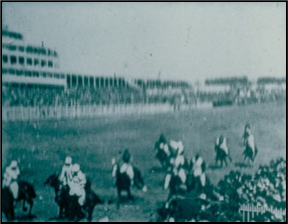 xxxxxAndxworthy of mention as a
film producer in these early days is the Englishman Birt Acres (1854-1918).
Partnered by Robert Paul
(1869-1943), a young mechanical engineer from London, he
invented his own projector, the Kineoptican, and filmed the
opening of the Manchester Ship Canal and Henley Regatta in 1894,
and the Epson Derby (clip illustrated) and the
University Boat Race in 1895. And in that year he became the first
roving newsreel reporter, visiting Germany to film the opening of
the Kiel Canal and Kaiser Wilhelm II reviewing his troops. His
actuality films were soon being shown in peep shows across Europe
and the United States, and his Birtac, a combined camera and
projector invented in 1898, was the first piece of equipment made
for the amateur film maker.
xxxxxAndxworthy of mention as a
film producer in these early days is the Englishman Birt Acres (1854-1918).
Partnered by Robert Paul
(1869-1943), a young mechanical engineer from London, he
invented his own projector, the Kineoptican, and filmed the
opening of the Manchester Ship Canal and Henley Regatta in 1894,
and the Epson Derby (clip illustrated) and the
University Boat Race in 1895. And in that year he became the first
roving newsreel reporter, visiting Germany to film the opening of
the Kiel Canal and Kaiser Wilhelm II reviewing his troops. His
actuality films were soon being shown in peep shows across Europe
and the United States, and his Birtac, a combined camera and
projector invented in 1898, was the first piece of equipment made
for the amateur film maker.
xxxxxLikexmany early pioneers in
the film industry, Acres could not cope with the fierce
competition and was declared bankrupt in 1909, but his assistant,
the Englishman Arthur Melbourne-Cooper (1874-1961) went on to become a prominent film
maker, responsible for a number of innovations in filming
technique. He formed his own company in 1901, the Alpha Trading
Company, and became especially known for his advertising films for
the likes of Bird’s Custard Powder, Bryant and May (the match
manufacturer), and Keen’s Mustard. At one time he was producing a
film a day to meet the growing demand, and these included
comedies, dramas and sporting events.
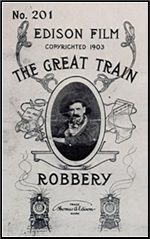
xxxxxAmongxthe most successful film producers in the United
States at this time was the American Mutoscope Company.
Established by William Dickson in 1895, after he left working for Edison, it was the
first company to be formed solely for the production of moving
pictures. At first it produced short clips for the peep-show
industry, but it then turned to the making of longer films to meet
the needs of the “cinema”, and it quickly became Edison’s chief
competitor. It produced its first Western
in 1902 - one year before Edison’s epic The
Great Train Robbery - and it took the first movies
of the Pope and an American President. Feature films followed and
brought about the birth of the movie star.
xxxxxMeanwhile
in France the film pioneer Georges
Méliès (1861-1938), starting in
1896, directed over 500 films in the space of sixteen years. He
produced a variety of subjects, including comedies, dramas, fairy
stories, histories and documentaries - such as The
Dreyfus Affair in 1899. Quite
a number were 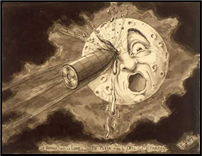 fantasies,
like his A Trip to the Moon, a piece of
science fiction in which the spacecraft hits the eye of the man in
the moon! (illustrated). In many of these he gained a reputation for his
special effects and his technical innovations. In 1897 he built
Europe’s first film studio at Montreuil, in eastern Paris, but in
the long term he was unable to compete with the larger companies,
and was forced out of business in 1912.
fantasies,
like his A Trip to the Moon, a piece of
science fiction in which the spacecraft hits the eye of the man in
the moon! (illustrated). In many of these he gained a reputation for his
special effects and his technical innovations. In 1897 he built
Europe’s first film studio at Montreuil, in eastern Paris, but in
the long term he was unable to compete with the larger companies,
and was forced out of business in 1912.
xxxxxIncidentally, Dickson’s Mutoscope Company sent a team out to
South Africa in 1899 to make a film about the Second Anglo-Boer
War and, while there, was assisted by a young journalist named
Winston Churchill.







 xxxxxThis public screening -
xxxxxThis public screening - xxxxxAxmore valid challenge was
that made by the German inventor Max
Skladanowsky (1863-
xxxxxAxmore valid challenge was
that made by the German inventor Max
Skladanowsky (1863-
 xxxxxAndxworthy of mention as a
film producer in these early days is the Englishman Birt Acres (1854-
xxxxxAndxworthy of mention as a
film producer in these early days is the Englishman Birt Acres (1854-
 fantasies,
like his A Trip to the Moon, a piece of
science fiction in which the spacecraft hits the eye of the man in
the moon! (
fantasies,
like his A Trip to the Moon, a piece of
science fiction in which the spacecraft hits the eye of the man in
the moon! (

